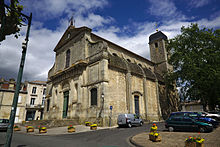Castillon-la-Bataille
| Castillon-la-Bataille | ||
|---|---|---|

|
|
|
| region | Nouvelle-Aquitaine | |
| Department | Gironde | |
| Arrondissement | Libourne | |
| Canton | Les Coteaux de Dordogne (main town) | |
| Community association | Castillon-Pujols | |
| Coordinates | 44 ° 51 ′ N , 0 ° 3 ′ W | |
| height | 2–104 m | |
| surface | 5.68 km 2 | |
| Residents | 3,166 (January 1, 2017) | |
| Population density | 557 inhabitants / km 2 | |
| Post Code | 33350 | |
| INSEE code | 33108 | |
 Town Hall ( Hôtel de ville ) |
||
Castillon-la-Bataille (to 1953 Castillon-sur-Dordogne ) is a French municipality with 3166 inhabitants (at January 1, 2017) in the Gironde department in the region Nouvelle-Aquitaine ; it belongs to the Arrondissement of Libourne and the canton of Les Coteaux de Dordogne . The municipality is located in the east of the department between Libourne and Sainte-Foy-la-Grande at a crossing over the Dordogne - the main reason for the importance of the city in the centuries of military conflicts within France.
history
In 732, at the river crossing, Abd ar-Rahman's troops defeated Duke Eudo of Aquitaine before he was defeated by the Franks under Charles Martell in October in the Battle of Tours and Poitiers .
Since the 10th century Castillon was the seat of a vice count . In 1060, Vice Count Olivier had Benedictine monks come from Saint-Florent-de-Saumur , who built a monastery north of the castle. Pierre de Castillon, companion of King Richard the Lionheart in the Holy Land , was the founder of Faize Abbey in 1137.
With the marriage of Eleanor of Aquitaine and Henry II of England , Castillon also became English in 1152, remained so until 1223 and then again until 1259. Due to a rebellion of the Barons Guyennes against Simon IV. De Montfort , the Castillon family lost the vice-county. The rule of Castillon came to the Counts of Foix at the end of the 13th century in the person of Jean II. De Grailly , Captal de Buch .
Sainte-Foy and Castillon were conquered by Raoul II. De Clermont , but on May 20, 1303 the rule of the English over the region was solemnly affirmed in the collegiate church of Saint-Emilion . In 1377 the Duke of Anjou besieged Castillon after conquering Bergerac and Sainte-Foy and took the city after 14 days. In 1451 Jean de Dunois conquered Bordeaux , after which Castillon, like all of Guyenne, came under the rule of Charles VII of France . The Vice Count Gaston de Foix refused to submit and went into exile in Spain. His son Jean de Foix joined the nobility of the Bordelais and the English under John Talbot - the Battle of Castillon on July 17, 1453 put an end to the Hundred Years War . Jean de Foix confirmed Castillon’s rights from his English exile, including the right to elect a mayor. King Louis XI. finally allowed him to return to the old state. In the middle of the 16th century, the Vice-Counties of Castillon passed from the House of Foix to the Vice-Counts of Turenne .
During the Huguenot Wars , the Marshal of France Blaise de Montluc seized the city; however, the behavior of his soldiers drove the residents of Henry of Navarre and Henri I de Bourbon into the arms. As a result, Castillon was besieged by Charles de Lorraine in 1586 . After two months the surrender took place, after which 22 citizens of the city were hanged. In 1588 it was reconquered by Henri de La Tour d'Auvergne, duc de Bouillon , in a surprise attack with 300 soldiers. Subsequently, Castillon was guaranteed a safe city for the faithful. In 1622, King Ludwig XIII requested by Henri de la Tour, vicomte de Turenne et de Castillon, the demolition of the castle, and also got his will.
On December 3, 1719, the Duke of Bouillon sold the Vice-County of Castillon to Antoine Bonnet de Talmont, who in 1731 sold it to André François Benoit Leberthon, the first President of the Parlement in Bordeaux. André Leberthon, his son, sold his property in 1795 after losing his manorial rights.
When the départements were formed during the French Revolution , Castillon was the administrative seat of a canton within the Arrondissement of Libourne. On November 27, 1953 - 500 years after the battle - the city of Castillon-sur-Dordogne was renamed Castillon-la-Bataille.
Population development
| year | 1962 | 1968 | 1975 | 1982 | 1990 | 1999 | 2006 | 2016 |
| Residents | 3108 | 3102 | 3166 | 3207 | 3020 | 3113 | 3148 | 3166 |
| Sources: Cassini and INSEE | ||||||||
Attractions
- Porte du Midi (south gate) or Porte du Fer (iron gate) within the city wall
- Baroque church of Saint-Symphorien (18th century)
- Hôtel de ville , the city's hospital until the Revolution (18th century)
- Wash house , built in the 19th century
- Church of Sainte-Marguerite in the district of Capitourlan
- Protestant Church
See also: List of Monuments historiques in Castillon-la-Bataille
Town twinning
- Nabburg , Upper Palatinate , Germany, since 1986
economy
Castillon is named for the wine-growing appellation Côtes de Castillon , which is operated in nine municipalities on 2850 hectares. The Côtes de Castillon appellation was spun off from the Bordeaux appellation in 1989 .
literature
- Le Patrimoine des Communes de la Gironde. Flohic Éditions, Volume 1, Paris 2001, ISBN 2-84234-125-2 , pp. 574-577.

